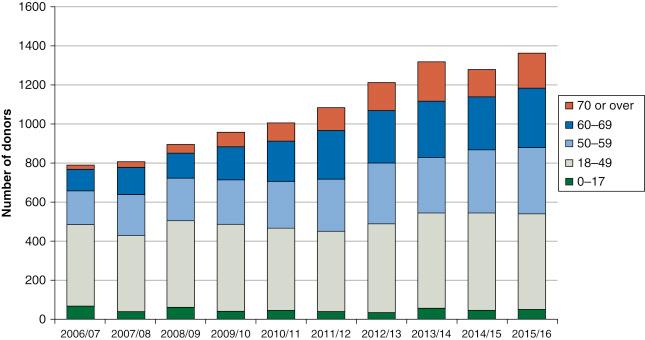Physical Address
304 North Cardinal St.
Dorchester Center, MA 02124
It is a favorite assertion of the authors that clinical transplantation is an excellent example of “medical ethics in practice.” Perhaps this is best demonstrated by the processes of organ allocation where a balance must be struck between allocation that makes best use of a scarce resource and the principle of equitable access to all on the waiting list.
It is important to acknowledge that, for the patient to receive an offer of a deceased donor kidney, they must have completed a two-step process. First, the patient must gain access to the waiting list. The preparation for listing and the criteria for this are covered elsewhere (see Chapter 4 ), but this is an important step and there is evidence of inequity in clinical processes to screen patients for access to the waiting list. This chapter will concentrate on the second step, which is allocation of a donor kidney to a patient who is already on the waiting list.
As transplantation from deceased donors develops in any particular country, the sophistication of allocation processes also matures. Early allocation plans may begin with a local clinician picking from a list of local patients, a system that is subjective, open to challenge, and does not maximize population size for matching. Allocation algorithms then develop regionally, and eventually result in a complex process that is usually run on a national basis by a designated organization. On occasion, an international collaboration is set up—perhaps the most notable example of this is Eurotransplant, which covers the nations of Germany, Belgium, Austria, Netherlands, Luxembourg, Slovenia, Croatia, and Hungary. The more advanced allocation schemes are safeguarded by legislative frameworks and appropriate governance processes.
The ethical dilemma in the design of allocation policies faced by all countries is the balance between utility and equity.
Utility-based allocation gives priority to those with the best chance of a favorable outcome—by this method gaining the maximum benefit from every transplanted kidney. Although this is a clear principle, the secondary question of how to measure the benefit is much more difficult to answer. Should this be based on survival statistics (kidney or patient), comparative benefit of life years gained, or should we include quality of life for each of the possible patients? In addition, an allocation system based purely on utility causes disadvantage to many patient groups—the elderly, diabetics, and those who have waited for a longer time.
On the other hand, equity, the concept that each patient should have an equal chance of receiving an offer, will result in a system that does not maximize the precious gift of a donor organ. For instance, a “queuing” or “first-come first-served” system gives priority to more elderly patients and those who have been on dialysis longer with more comorbidity, which mitigates against the best results.
Most allocation systems around the world were built on human leukocyte antigen (HLA) matching between donor and recipient. This stands to reason as a better match produces better survival. However, the unintended consequence of this allocation principle is that patients with rare HLA types (who also happen to be ethnic minorities in any community) and sensitized patients (who also happen to be mainly female) are disadvantaged.
It follows that allocation systems mature to be an amalgam between markers of utility and factors associated with fairness ( Table 24.1 ).
Sources: UK: NHS Blood and Transplant policy 186/9, effective 26/01/18. Available online at: https://nhsbtdbe.blob.core.windows.net/umbraco-assets-corp/6522/pol186-kidney-transplantation-deceased-donor-organ-allocation.pdf.
US: Organ Procurement and Transplantation Network policy 8, effective 08/10/17. Available online at: https://optn.transplant.hrsa.gov/media/1200/optn_policies.pdf#nameddest=Policy_08.
Eurotransplant: Eurotransplant foundation manual, Chapter 4 , version 5.2, effective 11/11/16. Available online at: https://www.eurotransplant.org/cms/mediaobject.php?file=H4+ETKAS+November+11%2C+20161.pdf.
Australia: The Transplantation Society of Australia and New Zealand, version 1.1, effective 17/05/17. Available online at: https://www.tsanz.com.au/organallocationguidelines/documents/ClinicalGuidelinesV1.1May2017.pdf.
| Allocation Criteria | UK | US | Eurotransplant | Australia |
|---|---|---|---|---|
| HLA MM loci/importance | DR > B | DR only | DR = B = A | DR > B/A |
| Waiting time definition | Listing date | Start of dialysis | Start of dialysis | Start of dialysis |
| Definition of pediatric recipient | <18 years, retain pediatric priority until transplanted | <18 years | <16 years or >16 yrs with growth potential on x-ray | <18 years, first dialysis <17 years and on dialysis for >1 yr |
| Recipient age (adults) | + | + | − | − |
| Donor-recipient age matching | + | − | + | − |
| Definition of highly sensitized recipient | CRF ≥85% | Sliding scale for CPRA 20–100 | PRA >85% | PRA >50% for 000 MM, >80% for all other MM levels |
| Priority for HLA homozygous recipients | DR, B | − | DR, B, A | − |
| Local allocation priority | + | + | + | + |
| Balance of exchange | − | − | + | + |
| Other allocation criteria/features | Defaulting of rare HLA antigens HLA match and age combined |
Priority for previous living organ donors EPTS KDPI |
Medical urgency AMP ESP |
Around 80% of kidneys allocated within donor state via state-based algorithms |
Age is also a controversial issue in allocation policies. Few would deny priority for pediatric patients because of the natural emotional response to help children, backed by the clinical issues peculiar to children with renal failure, including growth and developmental delay. Yet some systems have a strict cutoff between designation of a patient as a pediatric or adult, which seems harsh on the young person who has only strayed 1 day into the adult sector, losing all priority in the process. In addition, any priority for younger patients (even though utility would suggest that they will benefit to a greater extent) is often resisted and can be characterized as age discrimination. Some have advocated that the allocation of younger donor kidneys should be reserved for younger recipients (obviously accompanied by older donor kidneys allocated to older recipients) because this treats all patients in an age-matched fashion. The most modern schemes attempt to predict the likely longevity of the transplanted kidney, advocating better matched kidneys for those who are younger, and accepting a more poorly matched kidney for those patients who, on balance, have fewer years to survive.
Finally, the characteristics of donors have changed rapidly in recent years. More aged, higher body mass index (BMI), and more comorbidity in donors has been well demonstrated, resulting in terms such as “marginal” or “extended criteria” donor ( Figs. 24.1 and 24.2 ). The fair method of allocation that also gives maximum benefit of these donor kidneys provides a significant challenge for national transplant organizations.


Although these themes are universal, the national response has been varied depending on the prevailing clinical, patient, and political views. We will describe here two notable schemes and summarize the variation in some others.
Become a Clinical Tree membership for Full access and enjoy Unlimited articles
If you are a member. Log in here